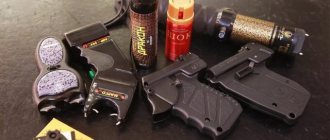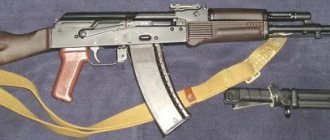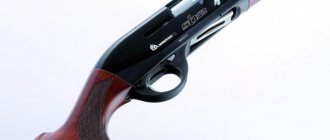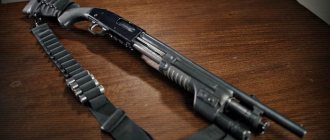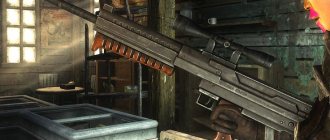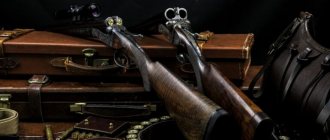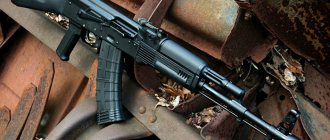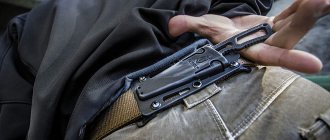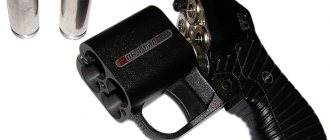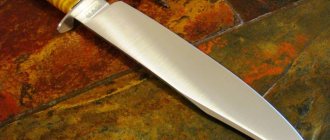Every week there is news in the media that people have been maimed as a result of the use of traumatic weapons. Motorists are sorting things out while shooting at each other, young people are shooting near nightclubs, and one gets the impression that our people, like the heroes of Westerns, are ready to shoot at each other anywhere.
DG decided to find out what weapons for self-defense are now available to mere mortals, how to use them correctly, and whether “our people” really shouldn’t be given firearms in their hands or whether these are horror stories from journalists. Vasily Zaitsev, a specialist from the Okhotnik store, dispelled myths and answered questions.
What weapons are allowed in the Russian Federation for self-defense
The types of weapons that can be used for self-defense without contradicting Article 3 of the relevant law of the Russian Federation include:
- Smooth-bore (including traumatic firearms).
- Barrelless with noise, light and other ammunition.
- Gas. This category includes revolvers, pistols, and gas cylinders.
- Electroshock.
Important. All products must be purchased legally in the store and comply with the current requirements of the Ministry of Health and the certification system of the Russian Federation.
A smoothbore weapon is a weapon without rifled channels in the barrel. Its initial bullet speed is obviously lower than that of a combat weapon. These are mostly shotguns and pistols. Barrelless weapons are so called because of their specific design: the cartridge chamber immediately goes into the barrel. A typical representative is “PB-4 Osa”. It is convenient that in this sample you can use flash-noise, gas, and traumatic cartridges.
With gas pistols and revolvers, everything is generally simple: they are loaded with special cartridges filled with an irritating substance. After the shot, the gas begins to act, causing lacrimation and shock in the attacker. Gas spray bottles work like household deodorants. Only they release not an air-refreshing stream, but a caustic substance.
Stun guns use the energy of an electric discharge, rendering the attacker unconscious: the device generates a high voltage current that is not dangerous, but painful for a person. The main emphasis in civilian weapons is that they are not lethal, that is, they cannot lead to serious injury or death. It is for this purpose that rubber bullets, gas cartridges and flash-noise cartridges are used as charges.
After all, the main goal when using “trauma” is to demoralize and break the enemy without causing him significant damage. There are many options for civilian weapons, both based on converted combat prototypes (PM, APS, IZH-78, Nagan), and independently created. The latter include “Wasp”, Guard MP-461”, “Thunderstorm”. They differ in cost, size, caliber.
Home Defense: 10 Best Non-Lethal Self-Defense Tools
Let's face it: the world is not a safe place. And although it seems to us that our homes are much safer than the streets, it is still better not to rely solely on the will of fate when it comes to our own safety. Of course, we do not yet live in an apocalyptic dystopia and the law “either you kill or they will kill you” is not yet applied everywhere, but we should not forget about banal robbers either. Therefore, you should always have a plan in case of action in such situations when you need to protect your home, property, health and lives of your own and loved ones. But the most obvious option - purchasing a firearm and getting a license for it - is not the best for many reasons.
The author, Sean Tirman from the United States, is not anti-guns per se. He simply believes that in some situations a 12-gauge shotgun is either not required at all or may not be available. And not everyone is ready to harm, or even kill, other people, even in self-defense. But this inability and unpreparedness does not mean that a person should be deprived of the right to self-defense. Especially when you consider that there are a lot of much less lethal and dangerous methods of self-defense. And it is precisely these means of self-defense that we will tell you about now.
The content of the article
Home Defense: 10 Best Non-Lethal Self-Defense Tools
#1. Pepper spray
Pictured is Saber 3-in-1 pepper spray.
The cost is about 7 bucks. Excellent proof that “non-lethal” does not mean “painless”. Pepper spray is a great way to calm or distract most attackers. Not only does the pepper burn even when it gets on the skin, but it can also get into the eyes to temporarily blind the enemy. The aerosol in the photo has a particularly effective braking ability, so it is used even by police who, for some reason, cannot take full-fledged weapons with them. It hits 3 meters and can be used up to 35 times, unlike many other disposable cans.
#2. Stun gun
Taser stun gun Vipertek VTS-989.
Costs about 17 dollars. If you are concerned about the possible adverse effects of using pepper spray, but don't mind getting within striking distance of an aggressor, then you should look at a stun gun - an effective option and not particularly expensive. One discharge is enough to briefly knock out anyone who is not stopped by his impressive appearance. The Vipertek VTS-989 Stun Gun's spiked electrodes are sharp enough to pierce thick clothing, and the extra shock plates on the sides of the device will thwart attempts to disarm you. Plus there is a flashlight and an internal rechargeable battery.
#3. Baseball bat
Brooklyn Crusher Baseball Bat by Cold Steel.
Costs approximately $31. What American hasn't held a baseball bat at least once in his life? Residents of other countries, however, are not so lucky. But even they understand that a bat, unlike pepper spray and stun guns, is much easier to use. ]Cold[/anchor] Steel, famous for its knives, is not limited to them. And for the production of this bat, not metal was used, but durable polypropylene, so it will be really difficult to break it.
#4. Shock Baton
Streetwise Security Barbarian Shock Baton.
Costs 36 dollars. The stun baton combines the simplicity of a baseball bat with the lethality of a stun gun. The 9 million volt discharge from the Streetwise Security Barbarian is no joke, and in any case you will find yourself at some distance from the attacker, so it will be more difficult to catch you. Plus a powerful electric CREE LED flashlight with three operating modes, which can be used not only to illuminate the space, but also to blind the enemy. And if neither the current nor the light helps, you can completely beat your opponent with it.
#5. Tactical flashlight
Flashlight Olight M1X Striker.
Costs 74 dollars. Those who are not ready to engage in physical confrontation with an attacker need something that will help them quickly escape. A special tactical flashlight is good for this purpose. It not only perfectly illuminates the space, but is also fully “tactical”, and therefore suitable for self-defense. The Olight M1X Striker has a flash mode of 1000 lumens, which is enough to blind anyone without proper eye protection. There is also a strobe mode, which also helps to disorient the enemy. And if all that fails, the durable serrated rim and overall structural strength allow this flashlight to be used as an impact weapon.
#6. Gas gun that shoots "bean bags"
ARMA-100 gas gun that fires bean bags.
Costs approximately $200. Pepper spray and electric shocks will, of course, slow down the attacker, but will not knock them down. But, for example, the special “gas gun” ARMA-100, which is a completely legal alternative to a weapon for self-defense, is very possible. Due to the compressed carbon dioxide, the gun emits a shock charge - “soft buckshot” (the so-called “bean bags”, non-lethal ammunition used by the US police), which flies at a speed of up to 40 meters per second - this is quite enough to stop the attacker. It's easy to shoot and even easier to aim. Especially at close distances.
#7. Home security alarm
Fortress security system.
Costs approximately $200. The best home security tool is one that works even when you're asleep or away. If this approach is close to you, then you need a reliable security alarm . For example, the Fortress security system allows you to monitor your home and surrounding area for suspicious movement. In addition, it reacts to impacts on sensors near windows or doors. To begin with, an alarm with a volume of 140 decibels, and then calls to 6 phone numbers playing pre-recorded messages. It can be disabled by entering a code from the keyboard or using several special key fobs. Plus there is an alarm button to activate the system manually.
#8. Gas pistol
Salt Supply gas pistol that shoots irritant balls.
Approximate price: 350 dollars. The pistol itself is an excellent stopping factor. And gas pistol is also an excellent non-lethal means of self-defense. It throws pepper gas capsules at a distance 10 times greater than the operating range of the canisters. The capsule, launched at a speed of 97 meters per second, opens upon impact and envelops the target in a cloud of irritant. However, this form of self-defense is not entirely legal in some states and countries - so check the laws beforehand.
Taser
Taser X26C. Costs almost 1000 bucks.
A Taser is essentially a hybrid of a pistol and a stun gun. Shoots two sharp electrodes, allowing you to work from a distance of 2-4 meters. The taser in the photo - the “legendary” X26C - is equipped with a replaceable battery and has a target range of 4.5 meters. And due to a special technology of neuromuscular interruption, it disables the target’s motor system. It even works against people under the influence of alcohol and drugs. If for some reason you cannot use a pistol, but regularly visit dangerous places, this is a good option.
#10. Dog
Even a small Chihuahua can raise the ears of the whole house with its barking if something is wrong. Not to mention full-fledged fighting or guard dogs. Of course, they need to be raised, fed and trained, but you get a really effective security system. The sight of an impressive dog can stop you almost better than a pistol, and its speed allows you to defend yourself even from aggressors with weapons. But this option is still not for everyone.
There are, of course, other non-lethal means of self-defense and home defense, but these are the best. Especially in those countries where normal firearms are prohibited by law for civilians.
Original article: Home Security: 10 Best Non-Lethal Self Defense Weapons
Purchase rules
Before you go to the nearest retail outlet for a specific purpose, to purchase a good “gas truck” or trauma, it is strongly recommended that you study the rules of sale.
First of all, all weapons are divided into 2 main categories:
- purchased without a license.
- requiring special permission.
If you haven’t previously asked about purchasing self-defense equipment, get ready to take the “exam”: study the rules for handling weapons. The scope and list of questions are determined by the Ministry of Internal Affairs. This necessarily includes certain sections of the Federal Law “On Weapons”, provisions of the Code “On Administrative Offences”, as well as actions to provide first-aid to persons caught in the fire of firearms or gas protective equipment. In addition, by default, Russians who are under 18 years old can forget about buying a “trauma” or a gun without a barrel. The acquisition of weapons is preceded by an application to the regional internal affairs body to obtain a license.
And there you have every right to demand:
- An application completed in accordance with all the rules.
- A copy of your personal identification document (passport or equivalent).
- Standard photo measuring 3x4 centimeters (2 pieces).
- A medical certificate that the applicant is mentally healthy has no contraindications for owning smooth-bore firearms.
Accordingly, unless one of the specified conditions is met, the issuance of a license will be refused. Failure also awaits those who are already serving a sentence for a crime (have an outstanding criminal record), administrative offenders. Even without a successfully passed test of knowledge in handling weapons, the license is as clear as your own ears. The same applies to citizens without a specific region of residence.
A separate category is made up of weapons without a license. Tear (irritant) gas aerosols, arresters and shock devices are purchased without special permits. Due to the miniscule weight of the bullet and the low initial velocity of the charge, pneumatic weapons are also not subject to strict legal restrictions for free acquisition. Although it is impossible to call it a full-fledged “means of self-defense” due to the above arguments. The exception is samples with a shot energy of more than 3 Kilojoules.
Important. After purchasing a self-defense weapon, the owner registers the purchased pistol or revolver with the police. 14 days are given for this, no more.
Rating of the most popular gun models
Let's look at the main technical characteristics of guns, which are very popular among citizens for self-defense.
Remington
The Remington 870 DM pump-action shotgun is positioned primarily as a “tactical” weapon for home defense.
These shotguns are one of the best in their class. Several modifications of this brand are produced, which differ in caliber. Remington is available in 4 calibers: 12, 16, 20 and 28. The body of the gun is steel, and the magazine is designed to hold 3 charges. Additionally, you can purchase a magazine extension, expanding it to 8 charges. The product is equipped with a pistol grip, a forend, and a Picatinny rail, which allows you to install an additional laser target pointer, a flashlight or a collimator sight.
Mossberg 500
This modification is produced in the USA. Models intended for self-defense usually have calibers 12, 20 or 410. The barrel length is 510 mm, and the magazine is designed to hold 8 charges. Another feature of the model is the installed fuse, which is located on top, and not on the side, like most other models. This provides easy access to it - to start shooting, you just need to change its position with your finger.
The cost of such weapons is quite high, and therefore you can take its Mexican analogue “Maverick 88”.
Winchester-1300
The Winchester 1300 model uses the Speed Pump system, which allows you to speed up the process of reloading the weapon after a shot; the bolt is unlocked immediately after the shot (when the pressure in the barrel bore decreases to a safe level)
Country of origin - USA. It is considered one of the most reliable in its class. An aluminum alloy is used to make the receiver; the caliber is 12/76 mm. The Winchester-1300 has many modifications, but for self-defense the most often chosen model is the one with a barrel length of 457 mm. These guns have become famous for their unique Speed Pump system, which allows the guns to be reloaded many times faster than similar models.
Shotgun MP-133
Country of origin: Russian Federation. This is the most common and popular model in Russia. The product is equipped with a special triple system that protects against inadvertent shooting. A high-strength aluminum alloy is used to cast the receiver. The gun is available in three caliber versions: 12/70, 12/76 and 12/89. For self-defense, experts recommend buying models with a barrel length of 540 mm, but you can also choose a slightly shorter option - 510 mm.
In what situations can it be used?
Jurisprudence defines the necessary conditions for application as critical when there is a specific threat to life. For example, a drunk neighbor decided to practice shooting at your windows. Or cheerful “guests” broke into your apartment, but not for tea and coffee, but for the purpose of robbery with the accompanying infliction of moderate and serious bodily harm.
Even in these cases, strictly follow the specific rules:
- Warning. It doesn’t matter how exactly you can convey to your opponent information about the fact of using a means of self-defense. This could be a clear verbal signal, “I have a gun! I will shoot! or a visual demonstration of cocking the bolt, loading the weapon.
- Direct shot. It is definitely not recommended to shoot traumatic cartridges at the head, closer than 1 meter. The choice is small - these are limbs (legs) or the body. In this case, the offender should not receive any serious injuries, especially injuries incompatible with life.
- "Call a friend." When the situation is resolved, dial “102” and wait for the patrol to arrive. He will have to talk about everything that happened, without hiding the details.
Unfortunately, what is so beautiful in abstract situations looks a little different in concrete ones.
- Moment one. While you loudly warn an aggressive client about the use of a weapon, he has plenty of opportunities to use it himself. Or stab you with a knife. So choose: stay alive and explain yourself to the police, or do “everything according to the rules” and be dead.
- Second moment. The representatives of the Ministry of Internal Affairs who rushed in will be very skeptical about the facts presented (especially if there are no witnesses). There is a real chance of getting into a situation of “exceeding self-defense.”
- The third moment. Do not touch the shell casings or the attacker’s weapon under any circumstances! And it is better to report what happened not only to the police, but also to friends, relatives, and a lawyer you know. The information provided will help avoid annoying mistakes, as well as the prospect of reclassification from a participant in the incident to the accused.
Where to store and wear
The rules for handling civilian weapons provide for certain standards for storage and carrying conditions. Violating them (and revealing the facts) entails potential problems with the police. More detailed information on these requirements can be found in government regulations and the Law “On Weapons”. In any case, access to the pistol and ammunition by third parties must be excluded.
At home
As a standard, lockable metal cabinets (safes) are used for home storage of self-defense equipment. The weapon itself is stored separately from ammunition, in an unloaded state. A police officer has the legal right to visit the owner of a “trauma” or “gas truck” license to see for himself that the current requirements regarding the presence (and storage) of weapons are met. Any counterarguments of the owner that impede the meeting are not taken into account.
With myself
Of course, carrying a weapon should ensure that it remains unloaded. In other words, for pneumatics this means the clip is removed or the cylinder is removed from the body, and for firearms it means the safety is on and there is no cartridge in the chamber. Otherwise, a “sudden” meeting with a patrol will lead to unnecessary explanations as to why the revolver in the bag or armpit holster is completely ready for battle.
